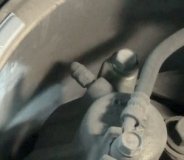If both sides are hot on front you might consider if something was done or happened recently that is causing the brake pedal to not release fully. If only one side is hot, since you already replaced the hoses, the next thing to suspect is contaminated brake fluid. Front-wheel-drive vehicles use a split-diagonal hydraulic system so the two front brakes are on different halves of the master cylinder. Only one side will be affected first if the fluid is contaminated with a petroleum product, but the other side will also be affected within a few days. To check for that, when the problem is occurring, crack open the steel line at the master cylinder. If you see a little spurt of fluid and the brake releases, the fluid is contaminated or the brake pedal is not fully released.
For fluid contamination, look at the rubber bladder seal under the reservoir cap. If it is blown up and mushy, you have a serious problem. If it seems normal, loosen the two mounting nuts that hold the master cylinder to the power booster a few turns. If the brakes release when you pull the master cylinder forward 1/8", the pedal is being held down a little. On some older cars that could be caused by a misadjusted brake light switch.
If the brakes do not release when the hydraulic system is opened at a steel line or bleeder screw, look at the caliper mounts to see if grooves have formed. The pads' backing plates can get caught on those grooves and fail to release. Typically that stops occurring after the pads and / or rotors are replaced because the new thicker parts places those backing plates in a different area on the mounts so they don't get caught. Even when the old parts are still installed and the problem is occurring, the pads will usually snap free from the jostling of removing the wheel. The proper way to fix those grooves is to replace the spindle if the mount is cast as part of it. You can replace just the mount if it's bolted onto the spindle. I've also repaired them by heating the area for a long time with an acetylene torch, then welding it with a wire feed welder to build the area back up, then grinding it flat. You have to heat it up first because they are made from cast iron which can shatter from the sudden heat of welding. You can file or grind the mounting surface down to eliminate the grooves but that will leave it with excessive clearance between the pads and mounting surface. That can cause an irritating but harmless single clunk each time you back up and hit the brakes, then again when you go forward and apply them.
To prevent those grooves from forming, always coat the pad-to-mount contact points with high-temperature brake grease.
Tuesday, August 7th, 2012 AT 12:11 AM


